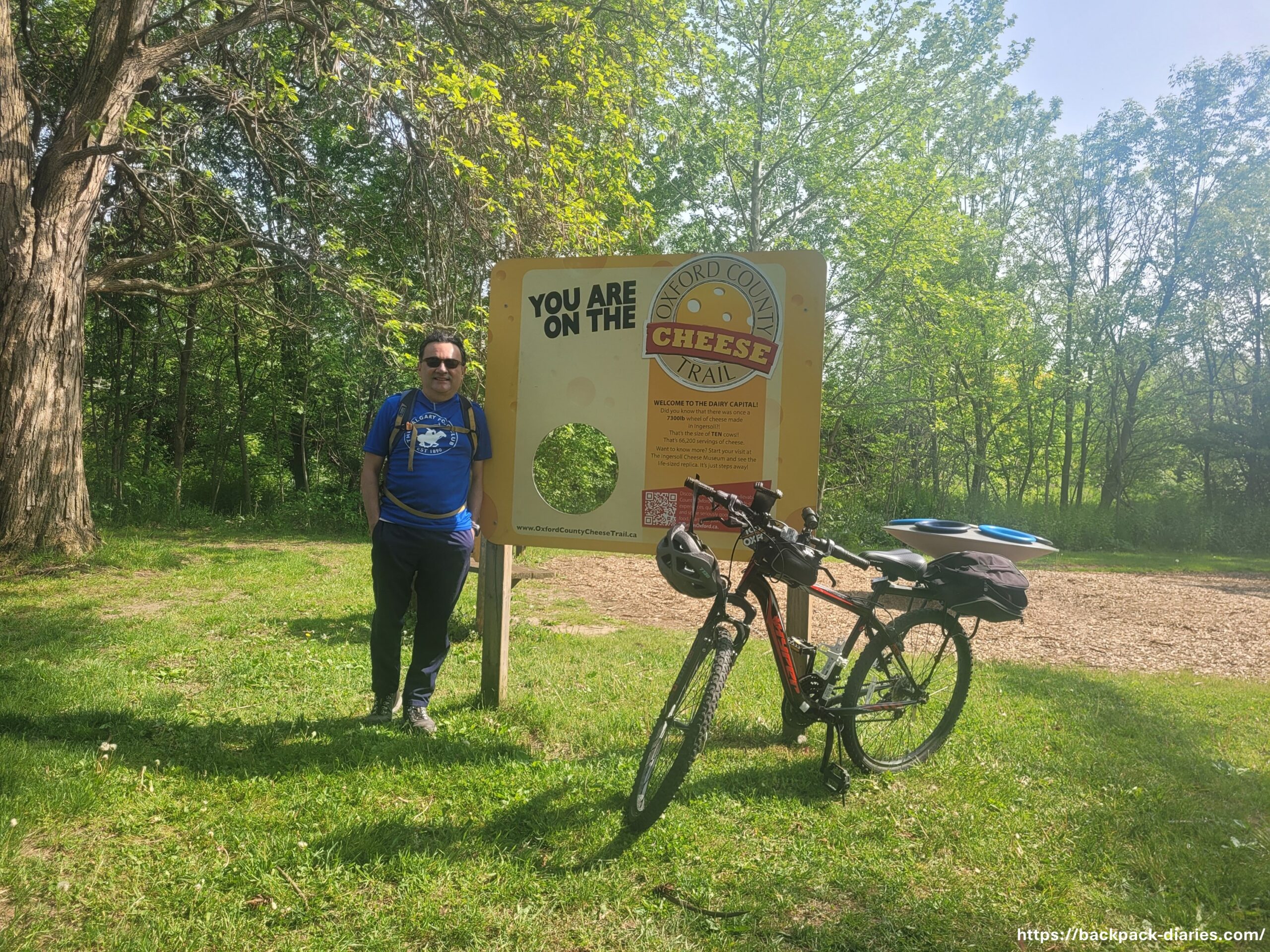During one of my projects, I worked in southern Ontario. I was impressed with the diverse economy across the province’s numerous counties. Oxford County, in particular, is renowned as Canada’s dairy capital, and it even has a “Cheese Trail” for visitors to explore. I planned to spend a weekend in May 2023 exploring this trail.

Oxford County
Oxford County is a regional municipality in southwestern Ontario, Canada. It is situated just east of London and southwest of Kitchener-Waterloo.
The Cheese Trail in Oxford County
I found it surprising that many people, not just in Ontario but across Canada, are unaware of the Dairy Capital of Canada. This region produces over a billion glasses of milk each year. So, what exactly is a cheese trail?
It is a self-guided tour of 24 stops featuring cheese, dairy, and related offerings for visitors. The trail runs through several communities along Oxford County, so a vehicle is primarily convenient. However, I combined my tour by carrying my bike in my truck. I drove to each major town and unloaded my bike to ride the nearby areas.

Available flyers and maps showing itineraries and cheese trail stops are very helpful and available at the visitor centre.
The itinerary in the map includes stops in three major towns of the region:
- Tillsonburg
- Ingersoll
- Woodstock.
As it was a hot weekend, I decided to camp at Long Point National Park, located South of Oxford County. Starting South-to-North on the cheese itinerary, my first stop was Tillsonburg.
Tillsonburg
Tillsonburg is a small town located in Oxford County, with a population of approximately 16,000 people.

I have visited Tillsonburg quite a few times during my frequent drives from Toronto to Sarnia. One of the main attractions of the town is the “Annandale House,” which features stunning indoor decorations that reflect the aesthetic movement. I would have loved to dedicate an entire blog post to this attraction, but unfortunately, photography was not allowed.

Going back to the cheese business, although Tillsonburg may not rival the dairy history of its neighboring communities, such as Ingersoll or Woodstock, there are still spots along the cheese trail worth exploring.
Two Girls and a Cheese Shop
I stopped at “Two Girls and a Cheese Shop” in Tillsonburg downtown.
Tracy and Shelley, the owners, are foodies at heart. They welcomed me warmly and shared their knowledge of cheese tasting.

The tasting experience began with sampling some of Ontario’s finest cheeses, including a bold and spicy selection from Stoney Creek, Ontario. It was followed by a cheese named “Dark Side of Moo.”
Then, after, I had a try on a sheep milk cheese from Lancey, Ontario, aged for a remarkable nine months, boasting a delightful crystallized texture and creamy richness.

During our conversation, we discussed pairing cheese with wine, coffee, and tea. I recalled my travels to Colombia, where I learned of the local tradition of dropping a piece of cheese into coffee to let it melt while savouring the unique combination.

Kelly suggested enjoying some Swiss-type cheeses cut into cubes and dropped into coffee that way. Tracy mentioned that it is becoming more common nowadays to have chocolate-covered beans on cheeseboards, too. They offered me some of these beans to try the next time at home in my charcuterie.

I was surprised to discover the diverse array of Gouda cheese varieties available, including smoked, coconut, lavender (with a hint of rosemary), and even a unique black variety resembling a shoe’s sole, flavoured with lemon, a popular choice on Halloween.
Also, the coconut-infused cheese is a popular choice during the summer months.

As my visit ended, I purchased a couple of sheep and goat cheese wedges.
Ingersoll
I kept driving 25 minutes north toward Ingersoll. With approximately 12,000 residents, Ingersoll is known for its history as a railway town and for its agricultural heritage.

Ingersoll can be considered the cradle of the Canadian cheese industry. In the late 19th and early 20th centuries, nearly 100 different factories were operating in the Oxford County. The town became known for its high-quality cheese, which was exported domestically and internationally to markets.
One of the spots worth visiting along the cheese trail here in Ingersoll is the Ingersoll Cheese Factory Museum.
Ingersoll Cheese Factory Museum
Located just across from the Ingersoll local museum, this is a replica of a 19th-century cheese factory. It was built in 1977 with a grant from the government of Canada on a site donated by the town of Ingersoll.

Techniques and equipment utilized in Canada’s early years of cheese production are on display. Among them is the cheese vat, a big container used for cheese preparation. Long-handled paddles within the vat were used all day to agitate the milk, starter, and rennet until they formed solid curds.

The museum offers informative displays detailing the history of cheese making in Canada and facts about the first cream cheese created in North America. Also, there are insights into pioneers such as Lydia & Hiram Ranney and the establishment of Canada’s first cheese factory in 1861.

An interesting historical note regarding Cheddar cheese is that despite its initial introduction by English settlers, a substantial quantity of Cheddar consumed in England from 1864 to 1920 was imported from Oxford County, Canada.

Also, the museum contains references, historical descriptions, and a carton mockup about one of the significant events in Ingersol’s history, the “Mammoth Cheese.”
Although the museum was small, I had the pleasure of exploring it alone during my visit. However, I wished for a more interactive experience.
Ingersoll’s Mammoth Cheese
The name sounds a bit joking, but the Mammoth Cheese was a historical event that projected world fame to this dairy area, specifically Ingersoll town.
In 1866, a 7300-pound block of cheese was created at the James Harris Cheese factory, which is situated along Highway 19, where the present-day “Elm Hurst Inn” is situated. I quickly stopped by to see the historical plaque.

It took milk from 2400 cows from over 250 area farms to produce 35 tons of milk needed for the mammoth cheese.
On August 23, 1866, after 3 months of aging, it was paraded throughout the streets of Ingersoll on its way to the train station.

It was an enormous block of cheese exhibited at the State Fair in Saratoga, New York, in 1866, then shipped to and showcased throughout England and Europe. Due to the event’s popularity and the excellent quality of the cheese, Oxford County in Canada became known as the “Dairy Capital of Canada.”
Fake news of the past about the cheesy fate
At that time, there existed a rumour that the “Mammoth Cheese” did not achieve much success during its journey to Europe. According to the unkind tale, the cheese never got offloaded in England as the mayor of Liverpool refused to permit it due to its overpowering smell.
It is possible that the story was initiated by American cheese exporters who aimed to discourage competition in a profitable market.

Red Dragon Dairy
I stopped briefly at spot 18 of the itinerary map South of Ingersoll and visited Red Dragon Dairy. This dairy is run by a family who moved to Canada from West Wales in 2007. During my visit, Matt welcomed me and showed me their cheese selection.

Red Dragon Dairy is known for their specialty in sheep milk cheeses. I had the opportunity to try various types of cheese, including curds, herb cheese, a fontina-style cheese made with sheep milk, and Pecorino, an Italian cheese.

Stay tuned for the second part of this blog series, where I delve into my visit to Woodstock and explore two renowned dairy factories: Gunn’s Hill Artisan Cheese and Mountainoak Cheese.
Thank you for taking the time to read this post. I appreciate your opinions, comments, likes, and shares.
If you find this post interesting, please feel free to share it or follow my Facebook or Instagram page.
I also invite you to read my previous post “Selena Quintanilla’s legacy in Corpus Christi: My visit to the Museum, Memorial and Her Final Resting Place”
Thank you and have a great day!
E.O.








